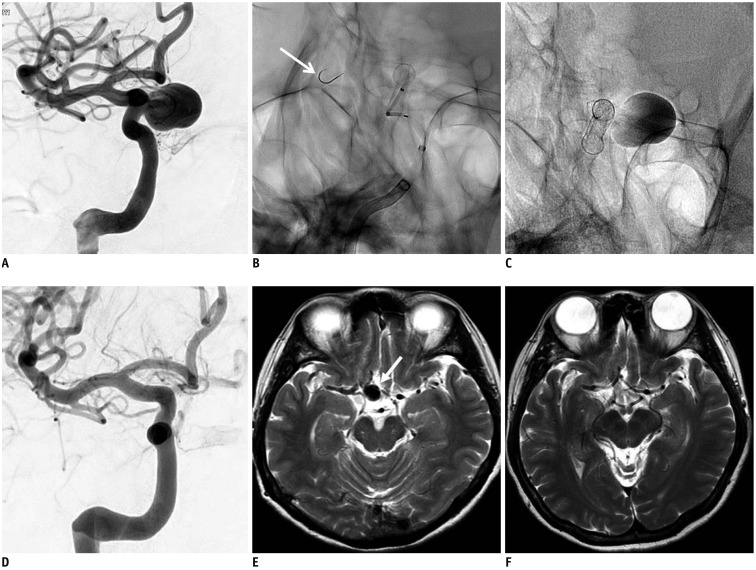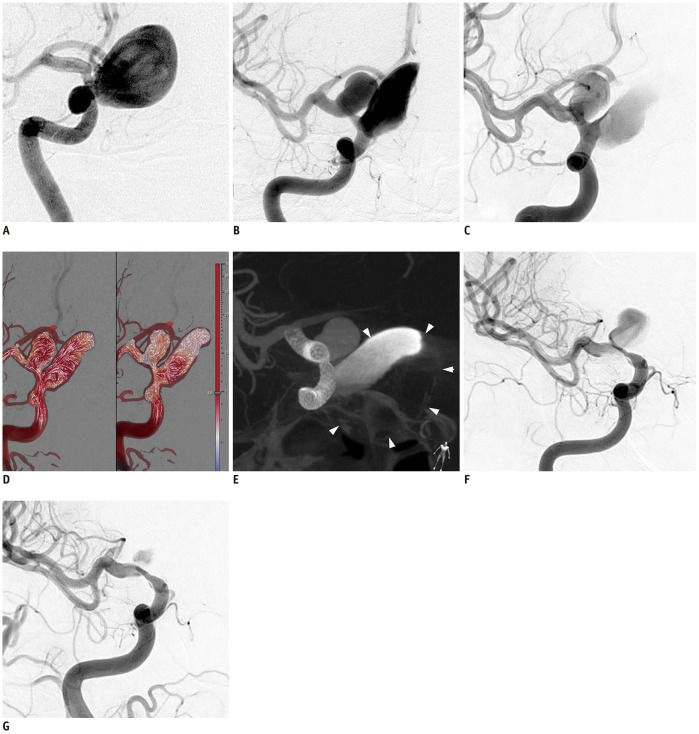Korean J Radiol.
2019 Mar;20(3):505-512. 10.3348/kjr.2018.0421.
A Newly-Developed Flow Diverter (FloWise) for Internal Carotid Artery Aneurysm: Results of a Pilot Clinical Study
- Affiliations
-
- 1Department of Radiology, Yonsei University College of Medicine, Severance Stroke Center, Severance Hospital, Seoul, Korea. bmoon21@hanmail.net
- 2Department of Neurosurgery, Yonsei University College of Medicine, Severance Stroke Center, Severance Hospital, Seoul, Korea.
- 3Department of Radiology, CHA Bundang Medical Center, CHA University, Seongnam, Korea.
- KMID: 2438281
- DOI: http://doi.org/10.3348/kjr.2018.0421
Abstract
OBJECTIVE
We report the results of a pilot clinical study that evaluated the safety and efficacy of a newly-developed, retrievable flow diverter (FloWise; Taewoong Medical) for the treatment of internal carotid artery (ICA) aneurysm.
MATERIALS AND METHODS
A total of 10 patients were enrolled. Inclusion criteria were 1) unruptured aneurysm with a dome size of ≥ 8 mm and a neck size of ≥ 4 mm at the ICA, or 2) two or more unruptured aneurysms of any size able to be spanned by a single FloWise at the ICA. Co-primary effectiveness end points were technical success of FloWise placement, and a 50% or greater decrease in aneurysm volume at the 6-month follow-up angiogram. The primary safety end point was the new development of neurological deficits persisting for more than 1-month post-treatment.
RESULTS
Ten patients harboring 14 ICA aneurysms (median diameter, 9.4 mm; range, 2.3-31.0 mm) were enrolled between January 2016 and July 2017. FloWise placement was successful in all patients. There were no newly-developed neurological deficits during the 6-month clinical follow-up period. One patient did not receive follow-up imaging due to pregnancy. Nine patients with 12 aneurysms received a 6-month angiographic follow-up. Ten aneurysms (83.3%) showed decreases in volume greater than 50% (mean volume decrease, 82.8 ± 32.9%), of which 8 (66.7%, 95% confidence interval, 35.4-98.0%) showed complete occlusion. One patient was retreated due to mass symptom aggravation.
CONCLUSIONS
In this pilot study, FloWise appeared to be safe and effective for ICA aneurysm treatment. A prospective multicenter study to validate the effectiveness and safety of FloWise would be worthwhile.
Keyword
MeSH Terms
Figure
Reference
-
1. Molyneux AJ, Kerr RS, Birks J, Ramzi N, Yarnold J, Sneade M, et al. ISAT Collaborators. Risk of recurrent subarachnoid haemorrhage, death, or dependence and standardised mortality ratios after clipping or coiling of an intracranial aneurysm in the International Subarachnoid Aneurysm Trial (ISAT): long-term follow-up. Lancet Neurol. 2009; 8:427–433. PMID: 19329361.
Article2. Raymond J, Guilbert F, Weill A, Georganos SA, Juravsky L, Lambert A, et al. Long-term angiographic recurrences after selective endovascular treatment of aneurysms with detachable coils. Stroke. 2003; 34:1398–1403. PMID: 12775880.
Article3. Becske T, Kallmes DF, Saatci I, McDougall CG, Szikora I, Lanzino G, et al. Pipeline for uncoilable or failed aneurysms: results from a multicenter clinical trial. Radiology. 2013; 267:858–868. PMID: 23418004.
Article4. Zhou G, Su M, Zhu YQ, Li MH. Efficacy of flow-diverting devices for cerebral aneurysms: a systematic review and meta-analysis. World Neurosurg. 2016; 85:252–262. PMID: 26434569.
Article5. Kallmes DF, Brinjikji W, Cekirge S, Fiorella D, Hanel RA, Jabbour P, et al. Safety and efficacy of the Pipeline embolization device for treatment of intracranial aneurysms: a pooled analysis of 3 large studies. J Neurosurg. 2017; 127:775–780. PMID: 27791519.
Article6. Zhang Y, Huang QH, Fang Y, Yang P, Xu Y, Hong B, et al. A novel flow diverter (Tubridge) for the treatment of recurrent aneurysms: a single-center experience. Korean J Radiol. 2017; 18:852–859. PMID: 28860903.
Article7. Kim BM, Kim DJ, Kim DI. A new flow-diverter (the FloWise): in-vivo evaluation in an elastase-Induced rabbit aneurysm model. Korean J Radiol. 2016; 17:151–158. PMID: 26798228.
Article8. Molyneux AJ, Kerr RS, Yu LM, Clarke M, Sneade M, Yarnold JA, et al. International Subarachnoid Aneurysm Trial (ISAT) of neurosurgical clipping versus endovascular coiling in 2143 patients with ruptured intracranial aneurysms: a randomised comparison of effects on survival, dependency, seizures, rebleeding, subgroups, and aneurysm occlusion. Lancet. 2005; 366:809–817. PMID: 16139655.
Article9. Campi A, Ramzi N, Molyneux AJ, Summers PE, Kerr RS, Sneade M, et al. Retreatment of ruptured cerebral aneurysms in patients randomized by coiling or clipping in the International Subarachnoid Aneurysm Trial (ISAT). Stroke. 2007; 38:1538–1544. PMID: 17395870.
Article10. Darsaut TE, Darsaut NM, Chang SD, Silverberg GD, Shuer LM, Tian L, et al. Predictors of clinical and angiographic outcome after surgical or endovascular therapy of very large and giant intracranial aneurysms. Neurosurgery. 2011; 68:903–915. discussion 915. PMID: 21221025.
Article11. Kim BM, Park SI, Kim DJ, Kim DI, Suh SH, Kwon TH, et al. Endovascular coil embolization of aneurysms with a branch incorporated into the sac. AJNR Am J Neuroradiol. 2010; 31:145–151. PMID: 19749218.
Article12. Rho MH, Kim BM, Suh SH, Kim DJ, Kim DI. Initial experience with the new double-lumen scepter balloon catheter for treatment of wide-necked aneurysms. Korean J Radiol. 2013; 14:832–840. PMID: 24043982.
Article13. Ihn YK, Kim BM, Suh SH, Kim DJ, Kim DI. Coil-protected embolization technique for a branch-incorporated aneurysm. Korean J Radiol. 2013; 14:329–336. PMID: 23482929.
Article14. Park KY, Kim BM, Kim DJ. Comparison between balloon-assisted and stent-assisted technique for treatment of unruptured internal carotid artery aneurysms. Neurointervention. 2016; 11:99–104. PMID: 27621946.
Article15. Jeon P, Kim BM, Kim DJ, Kim DI, Park KY. Y-configuration double-stent-assisted coiling using two closed-cell stents for wide-neck basilar tip aneurysms. Acta Neurochir (Wien). 2014; 156:1677–1686. PMID: 24969176.
Article16. Kim BM, Kim DJ, Kim DI. Stent application for the treatment of cerebral aneurysms. Neurointervention. 2011; 6:53–70. PMID: 22125751.
Article17. Benndorf G, Herbon U, Sollmann WP, Campi A. Treatment of a ruptured dissecting vertebral artery aneurysm with double stent placement: case report. AJNR Am J Neuroradiol. 2001; 22:1844–1848. PMID: 11733313.18. Fiorella D, Albuquerque FC, Deshmukh VR, Woo HH, Rasmussen PA, Masaryk TJ, et al. Endovascular reconstruction with the Neuroform stent as monotherapy for the treatment of uncoilable intradural pseudoaneurysms. Neurosurgery. 2006; 59:291–300. discussion 291-300. PMID: 16823325.
Article19. Park SI, Kim BM, Kim DI, Shin YS, Suh SH, Chung EC, et al. Clinical and angiographic follow-up of stent-only therapy for acute intracranial vertebrobasilar dissecting aneurysms. AJNR Am J Neuroradiol. 2009; 30:1351–1356. PMID: 19342544.
Article20. Suh SH, Kim BM, Park SI, Kim DI, Shin YS, Kim EJ, et al. Stent-assisted coil embolization followed by a stent-within-a-stent technique for ruptured dissecting aneurysms of the intracranial vertebrobasilar artery. Clinical article. J Neurosurg. 2009; 111:48–52. PMID: 19326976.21. Kim BM, Suh SH, Park SI, Shin YS, Chung EC, Lee MH, et al. Management and clinical outcome of acute basilar artery dissection. AJNR Am J Neuroradiol. 2008; 29:1937–1941. PMID: 18687744.
Article22. Kim BM, Chung EC, Park SI, Choi CS, Won YS. Treatment of blood blister-like aneurysm of the internal carotid artery with stent-assisted coil embolization followed by stent-within-a-stent technique. Case report. J Neurosurg. 2007; 107:1211–1213. PMID: 18077959.23. Lee BH, Kim BM, Park MS, Park SI, Chung EC, Suh SH, et al. Reconstructive endovascular treatment of ruptured blood blister-like aneurysms of the internal carotid artery. J Neurosurg. 2009; 110:431–436. PMID: 19046039.
Article24. Lim YC, Kim BM, Suh SH, Jeon P, Kim SH, Ihn YK, et al. Reconstructive treatment of ruptured blood blister-like aneurysms with stent and coil. Neurosurgery. 2013; 73:480–488. PMID: 23728453.
Article25. Jeon P, Kim BM, Kim DI, Park SI, Kim KH, Kim DJ, et al. Reconstructive endovascular treatment of fusiform or ultrawide-neck circumferential aneurysms with multiple overlapping enterprise stents and coiling. AJNR Am J Neuroradiol. 2012; 33:965–971. PMID: 22268079.
Article26. Cantón G, Levy DI, Lasheras JC, Nelson PK. Flow changes caused by the sequential placement of stents across the neck of sidewall cerebral aneurysms. J Neurosurg. 2005; 103:891–902. PMID: 16304994.
Article27. Kim M, Levy EI, Meng H, Hopkins LN. Quantification of hemodynamic changes induced by virtual placement of multiple stents across a wide-necked basilar trunk aneurysm. Neurosurgery. 2007; 61:1305–1312. discussion 1312-1313. PMID: 18162911.28. Kallmes DF, Ding YH, Dai D, Kadirvel R, Lewis DA, Cloft HJ. A second-generation, endoluminal, flow-disrupting device for treatment of saccular aneurysms. AJNR Am J Neuroradiol. 2009; 30:1153–1158. PMID: 19369609.
Article29. Kim BM, Shin YS, Baik MW, Lee DH, Jeon P, Baik SK, et al. Pipeline embolization device for large/giant or fusiform aneurysms: an initial multi-center experience in Korea. Neurointervention. 2016; 11:10–17. PMID: 26958407.
Article30. Kim T, Kwon OK, Lee H, Cho MJ, Jeong HJ, Ban SP. Nationwide mortality data after flow-diverting stent implantation in Korea. J Korean Neurosurg Soc. 2018; 61:219–223. PMID: 29526065.
Article31. Rajah G, Narayanan S, Rangel-Castilla L. Update on flow diverters for the endovascular management of cerebral aneurysms. Neurosurg Focus. 2017; 42:E2.
Article32. Liu JM, Zhou Y, Li Y, Li T, Leng B, Zhang P, et al. PARAT investigators. Parent artery reconstruction for large or giant cerebral aneurysms using the tubridge flow diverter: a multicenter, randomized, controlled clinical trial (PARAT). AJNR Am J Neuroradiol. 2018; 39:807–816. PMID: 29599173.
Article
- Full Text Links
- Actions
-
Cited
- CITED
-
- Close
- Share
- Similar articles
-
- Kinking of Flow Diverter in a Giant Wide-Necked Supraclinoid Internal Carotid Artery Aneurysm
- Symptomatic Post Endarterectomy Common Carotid Artery Pseudoaneurysm Treated with Combination of Flow Diverter Implantation and Carotid Stenting
- A New Flow-Diverter (the FloWise): In-Vivo Evaluation in an Elastase-Induced Rabbit Aneurysm Model
- Fracture of a Flow Diverter in the Cervical Internal Carotid Artery Due to Eagle Syndrome
- Internal Carotid Artery Reconstruction with a “Mega Flow Diverterâ€: First Experience with the 6×50 mm DERIVO Embolization Device




